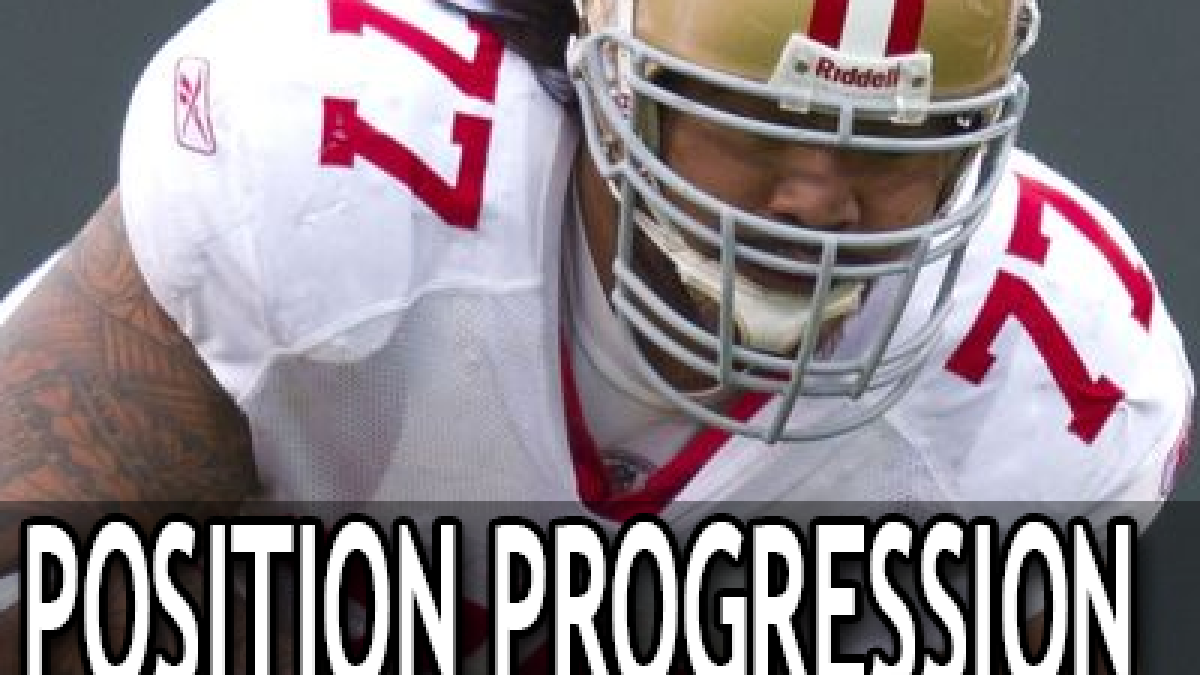 This week at PFF we are looking at the career progression of drafted players once they enter the league, and in this piece we turn our attention to offensive guards.
This week at PFF we are looking at the career progression of drafted players once they enter the league, and in this piece we turn our attention to offensive guards.
We've looked at every draft pick of the PFF era and analyzed their expected progression based both on snaps and grade and the bottom line is you are doing well if your rookie plays at an above average level in his first season in the league. There isn’t a single position that projects first-year players to perform better than the league average and some positions project them far below it.
Everybody is looking for immediate help from their rookie class, but the draft remains about building for the future, not necessarily the present.
The Curve
Much like what we saw for offensive tackles, the progression curve for guards is a steady climb through their first few seasons in the league, peaking with their fourth-year performances. Unlike tackle, however, even first-round guards cannot keep their heads above the average mark on average as rookies. First-round guards average a -1.0 grade as rookies, but quickly improve to an average of +13.6 in their fourth season.
While there isn’t a huge difference between first- and second-rounders at many positions, the gulf between them at guard early on is massive. While first-rounders are average players compared to the rest of the league at the outset, second rounders are struggling badly on average. As rookies their average grade has been -10.1 and it takes until year three for them to climb above average.
Best Case Scenario
Despite an injury-plagued fourth season in the league the best case scenario when selecting a first round guard is Mike Iupati. The 49ers' left guard has been a monster since being selected with the 17th pick of the 2010 draft, grading firmly in the double-digits every year until 2013. Iupati has a legitimate case to be seen as one of the league’s best guards and we would expect to see a return to that form in 2014, if healthy.
While most guards, even first rounder, struggle in year one, Iupati posted a +16.4 as a rookie, following it up with a comparable sophomore season and then a jump in performance in year three. He was dramatically outperforming the average from the outset at a position that statistics suggest takes more adjustment time than conventional wisdom dictates. There are a few other success stories amongst guards in the study but none so pronounced as Iupati and none with the potential upside he still carries to improve still further.
Worst Case Scenario
I’m cheating a little here by including a player drafted in 2006 – a year before we have PFF data – but the career body of work we have for Davin Joseph is too stark to ignore because we don’t have grading on his rookie season.
Joseph is the worst case scenario for a first-round guard because he is a player that didn’t just get cast aside as a busted flush early into his career, but somehow parlayed his consistently poor play into seven years of starting (not to mention two unfathomable Pro Bowl appearances).
Not once in that stretch did Joseph earn a positive PFF grade overall for a season, coming closest in 2011 with a -1.4 grade overall. He missed out on the chance to build on that the next year through injury and when he returned in 2013 he was worse than ever before, ending the year with a -32.8 grade. In total Joseph managed to amass a -74.7 grade over his career starting with the Bucs, significantly worse than any other guard in this study, averaging a -18.7 grade each season of play.
Swinging and missing on a first round guard is bad enough, missing and still making the run to first thinking you’ve hit a solid single is far worse.
The Path Mode Trodden
Many people still see the use of a first-round pick on an interior lineman as something of a waste, and if you’re drafting somebody that high he had better turn out great, but the data suggests that is pretty unlikely. In reality, the player you are likely to end up with looks far more like Ben Grubbs.
As with the offensive tackle position we covered, the average first round selection at guard is still a player you would be happy having on your roster, but it doesn't happen immediately. Grubbs graded negatively, though not disastrously as both a rookie and sophomore, accumulating a -8.1 grade over those two seasons, but then the light went on in year three and he hasn't looked back since.
From his third season onwards Grubbs has collected a +47.8 grade overall across multiple teams and schemes. It's probably fair to say that Grubbs has outperformed the developmental average for the position at this stage, ending up a very good player rather than merely a capable starter or above average guard, but he remains the closest fit for the player you are most likely to acquire with a first round selection at the position.
See the progression at other positions:
QB | RB | WR | TE | OT | G | C | ED | DI | LB | CB | S
Follow Sam on Twitter: @PFF_Sam



 © 2024 PFF - all rights reserved.
© 2024 PFF - all rights reserved.